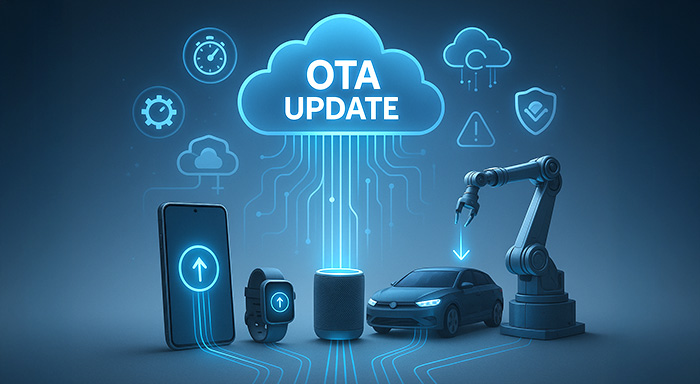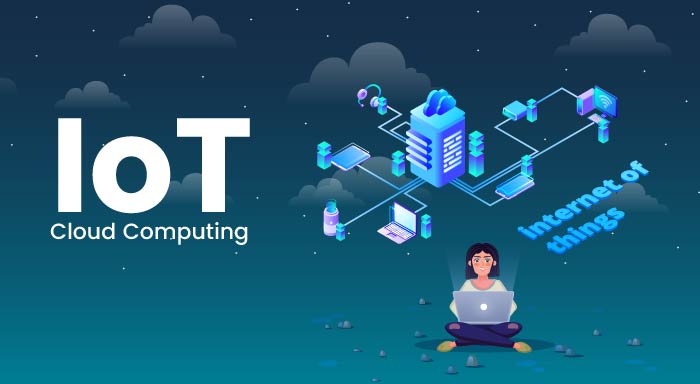The Internet of Things (IoT) relies on millions of networked devices that require to remain secure, up-to-date, and trustworthy. But how do companies update so many fleets of devices without physically interacting with every device? It is achieved through Over-the-Air (OTA) upgrades. OTA technology enables bug fixes, feature enhancements (new features) and improved device performance from anywhere. In this blog post will consider what OTA in IoT is, how it works, benefits, architectures, challenges and how it enhances the uses of IoT in different sectors.
What is OTA in IOT?
In the Internet of Things (IoT) context, OTA refers to the capability to deploy updates to networked devices, including sensors, smart home appliances, cars or industrial equipment, remotely. Maintaining devices secure and bug-free, and current with the latest functionality. OTA updates can guarantee that devices are kept current without ever having physical access to the device.
To the end-user, it seems like magic: devices are updating in the background, improving their performance and claim to have gained new features without any effort from you. OTA in IoT allows you to keep large fleets of devices reliable and ready for the future while streamlining the process of Monitoring IoT Devices.
An Over-The-Air (OTA) Update: What Is It?
The procedure of refreshing a device by wirelessly transferring new firmware, software, or setting is referred to as an Over-The-Air update. The update is transferring new firmware, software, or setting is referred to as an over the air update. The update is transferred straight to the device from the internet, making it not necessary to plug in cables or visit a service center. When your phone automatically installs the latest software versions on your own without asking., then you have most likely come across OTA updates.
How Do OTA Updates Work?
The smartest companies always plan their approach to device management before starting to create a solution. Teams most frequently use OTAs and manual updates, where a technician physically changes the hardware or uploads firmware to individual devices, to maintain connected devices functional and healthy.
Depending on the situation and the products involved, both approaches make sense, but switching from OTAs to manual updates or the way around is rarely a wise move. Ultimately, the first option needs to expand as you acquire more gadgets. At this point, selecting the best IoT platforms becomes essential to the smooth operation of OTAs.
How OTA Works in IoT
The Over-the-Air (OTA) update process in the Internet of Things (IoT) is to ensure devices remain secure, operational, and current without having to physically access them. Here is a step-by-step breakdown of how it works:
Update Creation – The software or firmware is developed by the manufacturer of the device. This can include bug fixes, security patches, performance improvements, or new features altogether.
Distribution – Once ready, the update is uploaded to a safe cloud server so that devices all over the globe may securely access and depend on it.
Delivery – The update is received wirelessly by the IoT device. Depending on the connectivity of the device, this can occur through Wi-Fi, cellular networks such as 4G/5G, or low-power wide-area networks (LPWAN), which are commonly employed in industrial IoT.
Installation – The tool checks the integrity and authenticity of the update prior to installation. This prevents malicious or corrupted files from being installed. Once checked, the update is installed automatically.
Confirmation – Once installed, the system does a check to ensure that the device is functioning normally with the new software. If problems arise, some devices are even capable of rolling back to the old version.
This OTA process without interruption guarantees IoT devices stay secure, trustworthy, and future-proof.
Advantages of Implementing OTA Updates in IoT Deployments
Selecting to implement your embedded devices with OTA updates is a strategic, scalable approach that'll make your IoT deployments practical from Day One.
Only when IoT hardware, device firmware, network connectivity, and an IoT device cloud work together intricately can an OTA update be successful. That's no small task, but OTA updates avoid weeks of toil and stratospheric expense. Check out how Particle makes it work here.
1. Once a product is in the field, it is easy to update.
Continually adding new software features to a product and whole systems will enhance its functionality and your customers will be pleased. As you innovate, all customers—current and former—are the beneficiaries.
2. You can quickly fix vulnerabilities and bugs on a large scale.
By detecting and fixing firmware OTA problems, businesses can prevent recalls, truck rolls, and general panic. Numerous items on your IoT security checklist can be crossed off with this.
Managing IoT-connected products and developing software naturally involve fixing bugs and security flaws. Rapidly resolving issues that disrupt services and cause chaos for clients is stressful for developers, but once a solution is found, they can implement it without requiring technicians and on-site assistance.
3. As a team, you can innovate more quickly.
Innovation flourishes when developers and architects of embedded solutions can swiftly prototype and release new firmware versions for devices. Teams frequently use Particle to automatically send firmware versions to their fleets, all with sensible safeguards to ensure responsible rollouts and to keep an eye on the health of the fleet for component compatibility and changes.
Typical Difficulties in OTA Update System Design
You're probably wondering if there are any drawbacks to OTA updates in order to offset their benefits. Even so, when you build on an integrated IoT Platform-as-a-Service, these are extremely rare.
That means, if you are deploying from a SIM, mobile virtual network operator, or in-house deployment, you can find it difficult to get the appropriate security solution, fight against device bricking, and maintain context awareness. Issues such as this often arise when a firm puts together a lot of point solutions.
Security
OTA updates make your devices vulnerable to rogue firmware attacks since there are additional entry points for attackers. To really protect your devices, we suggest that you install only trusted firmware using secure boot mechanisms. And let's be honest, getting products to market fast should never be at the cost of creating secure, reliable products.
To explain, a secure boot is an additional level of encryption and security for your customers that includes verifying your device's firmware and operating system against a known secure key installed on the device during manufacturing. Secure boot functionality prevents you from getting man-in-the-middle attacks at the application or firmware level.
In the U.K., secure boot has become mandatory for electric vehicles and EV charging points after a string of incidents when individuals tampered with charging stations.
Bricking of Devices
"Device bricking," or just "bricking," can be another OTA disadvantage in the absence of a platform like Particle. If you don't know, manufacturers refer to the process by which a developer turns a device into an expensive brick by pushing an OTA update as "bricking."
When pushing OTAs live, we advise always having a backup copy in your device's memory to prevent bricking. In this manner, in the event that a new update fails, your devices can roll back.
Recovery is frequently difficult or impossible if an update fails and you don't have a copy of an earlier version. Keep in mind the firmware's age and the number of application updates you perform because this is a big issue for legacy manufacturers with older devices.
Awareness of Context
Remember this golden rule of context awareness: Don't push OTA updates to devices that are currently in the midst of important operations or that customers are actively using.
If at all feasible, push OTAs during a product's low periods or choose to push updates in the background You can get creative with how your most recent updates reach your customers by using a platform with resumable OTAs to act as a "catch-all" after the initial push. Sometimes that simply cannot happen, and devices won't always need to be updated simultaneously.
Selecting the Best OTA Service and Pushing OTA Updates
OTA updates support the upkeep and enhancement of your linked devices. The advantages of effectively implementing changes at scale without depleting resources like network bandwidth, storage, processing power, or data efficiency greatly exceed the challenges posed by these updates.
Particles can assist if your business is thinking about implementing this type of device management. For individual devices, fleet segments, and entire fleets, we provide OTA services and cutting-edge architectures such as Asset OTA. Our OTAs are made to avoid the typical problems that arise when OTAs are pushed over a homegrown tech stack thanks to our fully integrated Platform-as-a-Service.
Final thoughts:
The use of Over-the-Air (OTA) updates is a cornerstone of modern IoT (Internet of Things) deployments. OTA updates represent time and cost savings in addition to giving organizations the ability to innovate more quickly, fix bugs even faster, and ensure devices are secure without needing to manage the devices physically. There is flexibility in design for deploying OTA updates starting from edge to the cloud model to more complicated Asset OTA which is a vital aspect of ensuring every use case is covered. While some may raise concerns around security, bricking devices, and timing affecting device performance, those are all manageable risks based on industry practices and existing tools. In adopting OTA, organizations are developing an IoT system ready for change, making it the best and most effective way to deliver value for organizations and customers.



